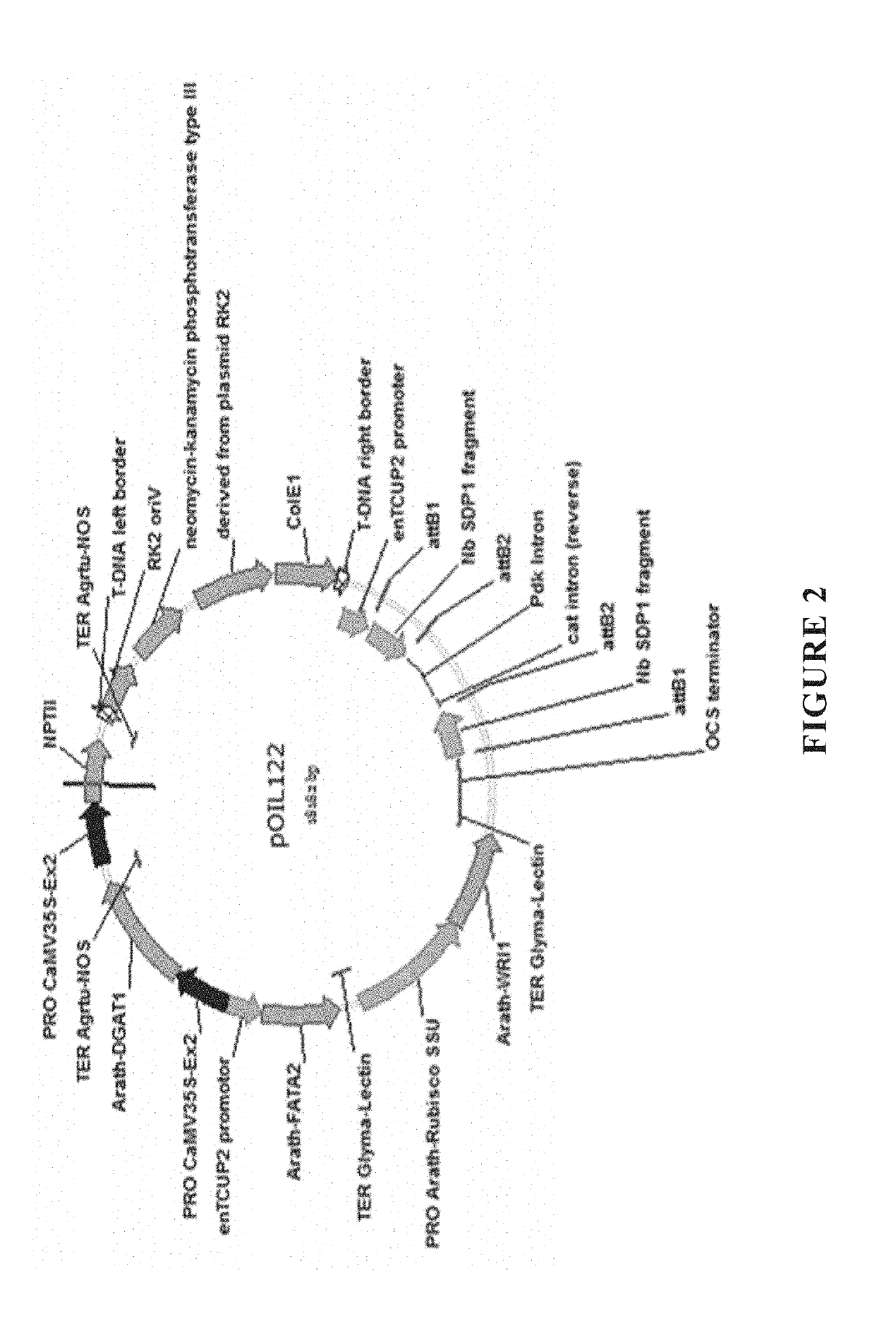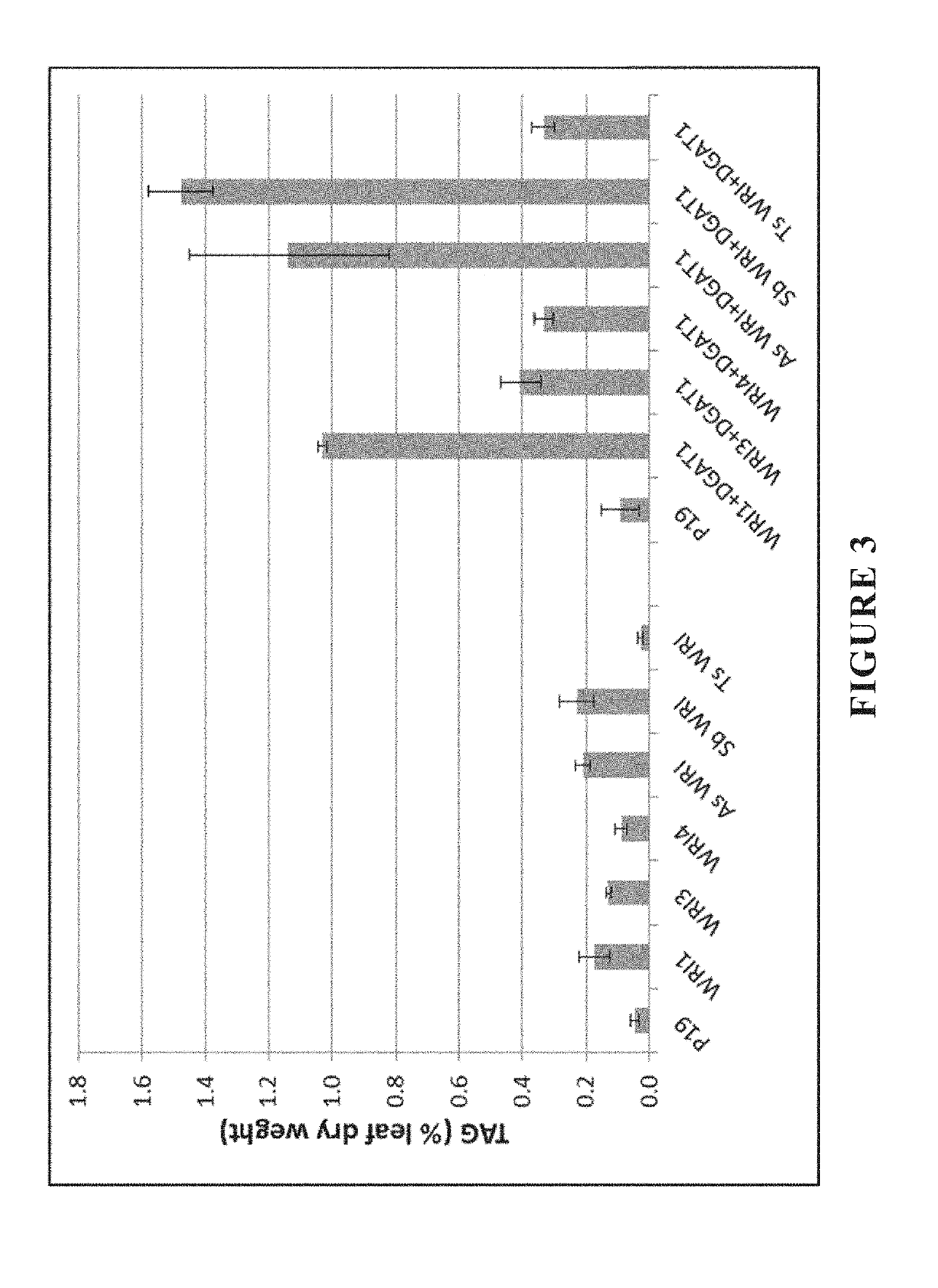Plants producing modified levels of medium chain fatty acids
a technology of medium chain fatty acids and plant lipids, which is applied in the direction of enzymology, fuels, transferases, etc., can solve the problems of affecting lipid flux, limited production of these crops, and agronomic performance, so as to increase the expression of photosynthetic genes, increase the content of total dietary fibre, and reduce the effect of td
- Summary
- Abstract
- Description
- Claims
- Application Information
AI Technical Summary
Benefits of technology
Problems solved by technology
Method used
Image
Examples
example 1
General Materials and Methods
Expression of Genes in Plant Cells in a Transient Expression System
[0837]Genes were expressed in plant cells using a transient expression system essentially as described by Voinnet et al. (2003) and Wood et al. (2009). Binary vectors containing the coding region to be expressed by a strong constitutive e35S promoter containing a duplicated enhancer region were introduced into Agrobacterium tumefaciens strain AGL1. A chimeric binary vector, 35S:p19, for expression of the p19 viral silencing suppressor was separately introduced into AGL1, as described in WO2010 / 057246. A chimeric binary vector, 35S:V2, for expression of the V2 viral silencing suppressor was separately introduced into AGL1. The recombinant cells were grown to stationary phase at 28° C. in LB broth supplemented with 50 mg / L kanamycin and 50 mg / L rifampicin. The bacteria were then pelleted by centrifugation at 5000 g for 5 min at room temperature before being resuspended to OD600=1.0 in an in...
example 2
Modifying Traits in Vegetative Parts of Monocotyledonous Plants
[0872]Chimeric DNA constructs were designed to increase oil content in monocotyledonous plants, for example the C4 plant S. bicolor (sorghum), by expressing a combination of genes encoding WRI1, Z. mays LEC1 (Accession number AAK95562; SEQ ID NO:32), DGAT and Oleosin in the transgenic plants. Several pairs of constructs for biolistic co-transformation were designed and produced by restriction enzyme-ligation cloning, as follows.
[0873]The genetic construct pOIL136 was a binary vector containing three monocot expression cassettes, namely a selectable marker gene encoding phosphinothricin acetyltransferase (PAT) for plant selection, a second cassette for expressing DGAT and a third for expressing Oleosin. pJP136 was first produced by amplifying an Actin-1 gene promoter from Oryza sativa (McElroy et al., 1990) and inserting it as a blunt-ClaI fragment into pORE04 (Coutu et al., 2007) to produce pOIL094. pOIL095 was then prod...
example 3
Increasing Expression of Thioesterase in Plant Cells
[0907]De novo fatty acid synthesis takes place in the plastids of eukaryotic cells where the fatty acids are synthesized while bound to acyl carrier protein as acyl-ACP conjugates. Following chain elongation to C16:0 and C18:0 acyl groups and then desaturation to C18:1 while linked to ACP, the fatty acids are cleaved from the ACP by thioesterases and enter the eukaryotic pathway by export from the plastids and transport to the ER where they participate in membrane and storage lipid biogenesis. In chloroplasts, the export process has two steps: firstly, acyl chains are released as free fatty acids by the enzymatic activity of acyl-ACP thioesterases (fatty acyl thioesterase; FAT), secondly by reaction with CoA to form acyl-CoA esters which is catalysed by long chain acyl-CoA synthetases (LACS). A. thaliana contains 3 fatty acyl thioesterases which can be distinguished based on their acyl chain specificity. FATA1 and FATA2 preferentia...
PUM
| Property | Measurement | Unit |
|---|---|---|
| weight | aaaaa | aaaaa |
| fatty acid composition | aaaaa | aaaaa |
Abstract
Description
Claims
Application Information
 Login to View More
Login to View More - R&D
- Intellectual Property
- Life Sciences
- Materials
- Tech Scout
- Unparalleled Data Quality
- Higher Quality Content
- 60% Fewer Hallucinations
Browse by: Latest US Patents, China's latest patents, Technical Efficacy Thesaurus, Application Domain, Technology Topic, Popular Technical Reports.
© 2025 PatSnap. All rights reserved.Legal|Privacy policy|Modern Slavery Act Transparency Statement|Sitemap|About US| Contact US: help@patsnap.com



